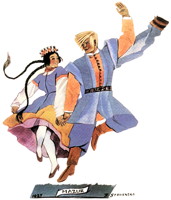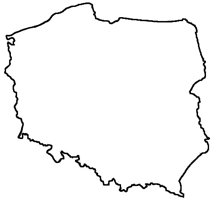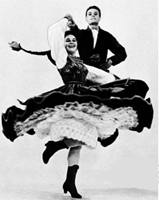
|
The Society of Folk Dance Historians (SFDH)
History of the Mazurka
[
Home |
About |
Encyclopedia | CLICK IMAGE TO ENLARGE |

|
 The Mazurka came very close to being just another name in the long list of historical dances. It was the lovely Mazurka music of Frederic Chopin that revived the dance for posterity. Chopin's fifty-six published Mazurkas served as a rich source of folk song and dance melodies, reflecting the charm and spirit of the people of Poland.
The Mazurka came very close to being just another name in the long list of historical dances. It was the lovely Mazurka music of Frederic Chopin that revived the dance for posterity. Chopin's fifty-six published Mazurkas served as a rich source of folk song and dance melodies, reflecting the charm and spirit of the people of Poland.
But let us go back to the year 1823 to the village of Żelazowa Wola near Warsaw where this talented Polish boy, thirteen years old, was on his first vacation away from the city. He loved to join in the festivals and dancing, all the while collecting those tunes and melodies that in later years attracted world wide attention to the Mazurka. His phenomenal memory enables him to repeat the peasant dance songs, the sounds of the peasant bands, and the choruses of the reapers, heard each summer during his teen years as he visited towns and villages in the Mazovian and Silesian regions. Between 1833 and 1847 every year saw the publication of his Mazurkas, Polonaises, and Polish songs. The beauty of the Mazurka rhythm inspired a great many renowned comosers to enrich the musical world with this Polish folk contribution.
So popular was this music that during the latter half of the 19th century some 225 composers published over 800 Mazurkas, exceeding even the Waltz and Polka of the same period, yet today's folk dancer finds little danceable Mazurka music available on recordings. A large segment of the world's most beautiful music lies buried in libraries and private collections both in the United States and Europe.
The recorded history of the Mazurka goes back to the year 1544 when it was a song accompanied by dancing. A German ethnologist believes that its origin dates back more than a thousand years to pagan times when the dance represented a nomadic rider abducting a girl. The name is derived from the ancient Palatinate of Masovia, and it was often called the Mazur, so named from the Mazurs who inhabited Mazovia.
Old books also give such spellings as Mazourka, Mazurek, or Masure. Today the true Polish dance is more often referred to as a Mazur. Von Planitz (1850) told of Polish dancers that were introduced to Germany about 1640 that had the characteristic 3/4 time and cadence of the Mazurka. This was about the time when 3/4 rhythm was exerting a powerful cultural influence over western Europe, and it was not long after the Swedish invasion of Poland in 1655 when Mazurka music became popular in Sweden. Later, influenced by the 3/4 time of the Mazurka, the Hambo was born, and the Polska and other Polish dances began to appear.
 The Mazurka is of moderate tempo, slower than that of the Viennese Waltz and little faster than that of our Waltz. The music usually consists of two or four parts of eight bars, each part being repeated. Frequently the musical phrase ends with the second beat, so that the third becomes an up-beat to the next bar. The rhythm is characterized by an accent that occurs on the second beat and that gives rise to the familiar ending of many enchainments in Polish dances, such as two stamps of the feet or a clicking of the heels. Even as today, singing usually accompanied the dance, although writers tell of Polish shepherds playing the bagpipe, or a violin and small hand drum, or sometimes only a harmonica as accompaniment. Sometimes there was singing for part of the dance and only instrumental music for the rest, or merely the voices of the spectators and their rhythmic stamping of feet. Benet describes a full village band of Chopin's time that included several violins, cello, flute, clarinet, horn, bass viol, and a gensla (a sort of zither). The village social gatherings was a welcome opportunity to dress up, and the colors of their costumes were as vivid as the music.
The Mazurka is of moderate tempo, slower than that of the Viennese Waltz and little faster than that of our Waltz. The music usually consists of two or four parts of eight bars, each part being repeated. Frequently the musical phrase ends with the second beat, so that the third becomes an up-beat to the next bar. The rhythm is characterized by an accent that occurs on the second beat and that gives rise to the familiar ending of many enchainments in Polish dances, such as two stamps of the feet or a clicking of the heels. Even as today, singing usually accompanied the dance, although writers tell of Polish shepherds playing the bagpipe, or a violin and small hand drum, or sometimes only a harmonica as accompaniment. Sometimes there was singing for part of the dance and only instrumental music for the rest, or merely the voices of the spectators and their rhythmic stamping of feet. Benet describes a full village band of Chopin's time that included several violins, cello, flute, clarinet, horn, bass viol, and a gensla (a sort of zither). The village social gatherings was a welcome opportunity to dress up, and the colors of their costumes were as vivid as the music.
Many historians described the general movements of the Mazurka, but said little about the actual footwork or step patterns. The words of the famous french dance master Cellarius (1847) are typical, "The Mazurka is composed of impulse, majesty, unreservedness, and allurement. It has even something of the proud and the warlike. It is a dance of independence, truly of inspiration, and which has no rule but the taste and peculiar fancy of the dancer, who in no case must allow himself to be languid or inanimate. The Poles are accustomed to dance it from infancy, which necessarily gives them great advantage as to style and originality." And in the words of Franz Liszt, "As if in the pride of defiance, the cavalier accentuates his steps, quits his partner for a moment as if to contemplate her with renewed delight, rejoins her with passionate eagerness, or whirls himself rapidly around as though overcome with sudden joy . . ." Von Planitz wrote, "It is a dance of encounter and separation, in which the couples may perform an unlimited variety of steps and if the mood is right and the company congenial, a leading couple will start the dance and the man calls out the change of figures. Others follow from the sides until the group forms into four corners or eight depending on the number of couples, and it was not uncommon to see the entire family, both young and oldsters dancing together as happy groups."
Three times Poland has been wiped off the map. War and occupation destroyed museums, libraries, and practically everything in the field of music and dance life. World War I and other early day records are no longer available; some early 19th century German and French publications, however, were useful in reconstructing some of the old Polish dances. Steps and figures of the Obereks, Polonaises, Sztajereks, Kujawiaks, and Krakowiaks are also found in the Mazurkas and mention is made by several writers that over a hundred different figures were used. Poland was one of the few countries where the leaders called out the figures as they pleased, and this was frequently noted by writers in describing both the Krakowiaks and Mazurkas. Some of the figures are found in early American Quadrilles and some are still used in today's Square Dances.
The Mazurka step is probably as old as the dance from which it takes its name. During Chopin's time it became popular as a ballroom dance and created as much interest as the early Polka. Descriptions of the step given in 16th century German and French dance books indicate that it was often used in combination with various other step patterns. Von Planitz told of finding the step used by french peasants in their Quadrilles and added that he saw the step used in their Branles and Bourrées, where it lost much of its lively Polish spirit mainly because of the dancer's wooden shoes. French peasants generally wore sabots (simple shoes shaped and hollowed out from a single block of wood) and therefore had to tone down the high steps and kicks of Polish dances or their wooden shoes would fly off. In 1588, Bishop Arbeau, in his "Orchesography" told of dancing a Branle with the maidens of Poitiers and described how they divided the step sequence by means of an agreeable noise they made with their wooden shoes.
The Mazurka step found some attraction in England about 1845 where it was used in the Cotillion. Later, Cellarius, in his "Fashionable Dancing" (France 1847) described the figures of his Quadrille-Mazurka where the step was used in the promenade sequence, and his Waltz Mazurka where the step was "applied to the evolutions of the Waltz." He also describes some sixty Cotillions containing the Mazurka step usually in combination as a waltz-Mazurka and polka-Mazurka. Moving across the Atlantic we find that a Polish immigrant named Węgierski established in Buffalo, New York about 1835 a prosperous school of dance and fencing where he introduced the Mazurka as well as other native Polish dances. Polish dancing was said to be an important requirement of a fencing course and this was noted in an old 18th century German fencing manual that described a Mazurka among other dance movements for training of leg muscles in fencing. Later a dance master named Allen Dodworth introduced the step in his ballroom classes during 1850 when the Polka-Mazurka enjoyed some attraction. Its popularity continued through the early 1920s and a good description is given in the early edition of Mr. and Mrs Henry Ford's book called "Good Morning."
It was not until the unsuccessful insurrection against Russia in 1830 that considerable numbers of Poles began to migrate to the Americas and with them went their songs, dances, and traditional customs. A fascinating study in dance research is the migration and permutations of steps and figures and the Mazurka step with its many international variations is perhaps the most interesting. One of the best known variations is found in our lovely Varsouvienne that first became popular in Paris and Madrid during 1846. It was invented by a young Spanish dance teacher, fully trained in the graces of the Minuet and inspired by the popularity of the French ballroom version of the Mazurka. The fashionable dances of this time traveled to other countries as rapidly as the newest Paris fashions and La Varsouviannna appeared in Spanish California from Monterey to Santa Barbara prior to 1849. Lucile Czarnowski, in her "Dances of Early California Days" gives four variations of this dance and also describes the Mazurka step that was already well known among the early settlers. Varsouvienne is a French word meaning "of (or from) Warsaw" and is also the name of the dance position already well known to French ballroom dancers. Dodworth also described several old and new variations that he taught in his New York classes in 1853. While this ever popular Mazurka Waltz requires a certain type of Waltz music, you can dance the Varsouvienne to any Waltz in the correct tempo. The step pattern is described in "Folk Dances from Near and Far" and several versions of this delightful dance are also given in Lloyd Shaw's "Round Dance Book."
Here are some dances of various countries that contain the basic step or interesting variations. From Germany, Mecklenburger Mazurka, Waltz Mazurka, and Black Forest Mazurka; from Italy, The Graziella Mazurka; Swedish Mazurka, Philippine Mazurka, Martinique Mazurka; from Finland, the Pottku Mazurka; from Switzerland, Scardanaler Mazurka; and from Switzerland, Märtgassler. And there are many Mazurkas that do not include the step but are done to Mazurka music.
BIBLIOGRAPHY
- Benet, Sula. "Song, Dance & Customs of Peasant Poland," London, 1951.
- Cellarius. "Fashionable Dancing," Paris, 1847.
- Czarnowski, Lucile. "Dances of Early California Days," Palo Alto, 1950.
- Dodsworth, Allen. "Dancing and Its Relations to Education and Social Life," New York, 1885.
- Schimmerling. "Folk Dance Music of teh Slavic Nations.
- Von Planitz, Frederick. "Observations On Dancing in Germany, France and Poland," Strasbourg, 1850.
- Wierzynśki. "The Life and Death of Chopin," New York, 1949.
DOCUMENTS
From "The Mazurka," Let's Dance! magazine, Vol. 22, No. 4, April 1965.
This page © 2018 by Ron Houston.
Please do not copy any part of this page without including this copyright notice.
Please do not copy small portions out of context.
Please do not copy large portions without permission from Ron Houston.